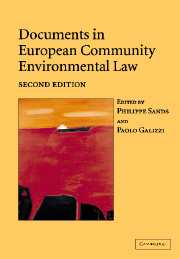Book contents
- Frontmatter
- Contents
- Preface
- PART I General principles of EC environmental law
- PART II European Community institutions and legislation
- PART III The relationship between environmental protection, financial assistance and free trade
- PART IV Procedural techniques of environmental protection
- PART V Protection of air quality
- PART VI Biodiversity and nature conservation
- PART VII Waste
- 33 Council Directive 75/442/EEC of 15 July 1975 on waste (OJ L 194 25.07.1975 p. 39)
- 34 Council Directive 91/689/EEC of 12 December 1991 on hazardous waste (OJ L 377 31.12.1991 p. 20)
- 35 Council Regulation (EEC) No 259/93 of 1 February 1993 on the supervision and control of shipments of waste within, into and out of the European Community (OJ L 030 06.02.1993 p. 1)
- 36 Council Directive 1999/31/EC of 26 April 1999 on the landfill of waste (OJ L 182 16.07.1999 p. 1)
- 37 Directive 2000/53/EC of the European Parliament and of the Council of 18 September 2000 on end-of-life vehicles (OJ L 269 21.10.2000 p. 34)
- 38 Directive 2000/76/EC of the European Parliament and of the Council of 4 December 2000 on the incineration of waste (OJ L 332 28.12.2000 p. 91)
- PART VIII Dangerous substances
- PART IX Water quality
38 - Directive 2000/76/EC of the European Parliament and of the Council of 4 December 2000 on the incineration of waste (OJ L 332 28.12.2000 p. 91)
from PART VII - Waste
Published online by Cambridge University Press: 06 January 2010
- Frontmatter
- Contents
- Preface
- PART I General principles of EC environmental law
- PART II European Community institutions and legislation
- PART III The relationship between environmental protection, financial assistance and free trade
- PART IV Procedural techniques of environmental protection
- PART V Protection of air quality
- PART VI Biodiversity and nature conservation
- PART VII Waste
- 33 Council Directive 75/442/EEC of 15 July 1975 on waste (OJ L 194 25.07.1975 p. 39)
- 34 Council Directive 91/689/EEC of 12 December 1991 on hazardous waste (OJ L 377 31.12.1991 p. 20)
- 35 Council Regulation (EEC) No 259/93 of 1 February 1993 on the supervision and control of shipments of waste within, into and out of the European Community (OJ L 030 06.02.1993 p. 1)
- 36 Council Directive 1999/31/EC of 26 April 1999 on the landfill of waste (OJ L 182 16.07.1999 p. 1)
- 37 Directive 2000/53/EC of the European Parliament and of the Council of 18 September 2000 on end-of-life vehicles (OJ L 269 21.10.2000 p. 34)
- 38 Directive 2000/76/EC of the European Parliament and of the Council of 4 December 2000 on the incineration of waste (OJ L 332 28.12.2000 p. 91)
- PART VIII Dangerous substances
- PART IX Water quality
Summary
Editorial note
Directive 2000/76 of 4 December 2000 aims to prevent or to limit as far as practicable negative effects on the environment, in particular pollution by emissions into air, soil, surface water and groundwater, and the resulting risks to human health, from the incineration and co-incineration of waste. This aim is to be met by means of stringent operational conditions and technical requirements, through setting emission limit values for waste incineration and co-incineration plants within the Community and also through meeting the requirements of Directive 75/442/EEC (Article 1). The Directive covers incineration and co-incineration plants, with some exceptions specifically listed in the instrument (Article 2).
No incineration or co-incineration plant is to operate without a permit, to be obtained from the competent authority (Article 4). Permits are given by the competent authority if the conditions laid out by the Directive are met. The competent authority shall periodically reconsider and update the permit conditions. The competent authority is to enforce compliance with the permit conditions (Article 4). The operator of the incineration or co-incineration plant is to take all necessary measures concerning the delivery and reception of waste in order to prevent or to limit as far as practicable negative effects on the environment (Article 5). Operating conditions for incineration and co-incineration plants are specified by Article 6. Incineration and co-incineration plants are to be designed, equipped, built and operated in such a way that the emission limit values set out in Annexes to the Directive are not exceeded in the exhaust gas (Article 7).
- Type
- Chapter
- Information
- Documents in European Community Environmental Law , pp. 716 - 740Publisher: Cambridge University PressPrint publication year: 2006
- 6
- Cited by



